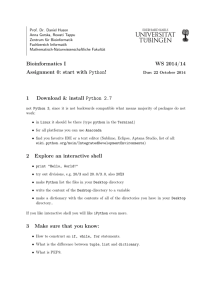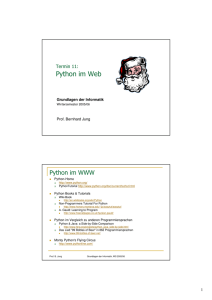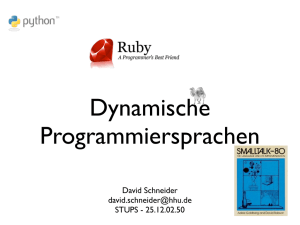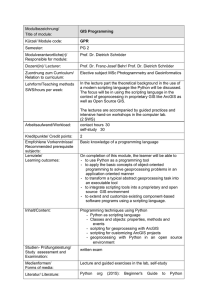Introduction to Python
Werbung
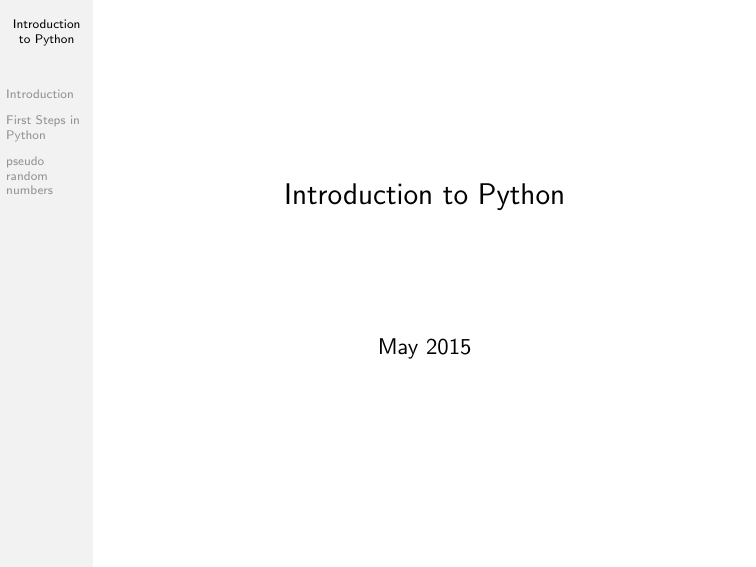
Introduction to Python Introduction First Steps in Python pseudo random numbers Introduction to Python May 2015 Introduction to Python What is Programming? Introduction First Steps in Python pseudo random numbers • All computers are stupid. • All computers are deterministic. • You have to tell the computer what to do. • You can tell the computer in any (programming) language) you like. Introduction to Python What is Python? Introduction First Steps in Python pseudo random numbers • Python is a very powerful, but easy language, and relatively fast. • Why easy? You can learn it easily. It is like writing down logic in pseudocode, only that the pseudocode is the real code (Unlike many other programming languages)! • Why powerful? There is nearly nothing you cannot do: Calculate, Draw, Plot, Read data (from anywhere), Simulate, Analyse data, Web applications, Make real executable programs (GUI), interactive programs, ... • The best thing: Open Source: Probably somebody in the world has already done what you want to do. Introduction to Python Workflow Introduction First Steps in Python pseudo random numbers • Write your code/program. • (No compiling step necessary) • Execute your program. Other languages: C,C++, Fortran. You have to compile, after writing your code, before executing! Introduction to Python Executing python online Introduction First Steps in Python pseudo random numbers • www.trinket.io • Sign up. • Write your code. • Run it. Introduction to Python Our first line of code Introduction First Steps in Python pseudo random numbers Variable definition CODE: • name = value Introduction to Python Console Output Introduction First Steps in Python pseudo random numbers CODE: • print name Introduction to Python Variable type Introduction First Steps in Python pseudo random numbers CODE: • print type(name) Introduction to Python Math expressions Introduction First Steps in Python pseudo random numbers CODE: • a + b • a - b • a * b • a / b • a ** b Introduction to Python Importing libraries Introduction First Steps in Python pseudo random numbers CODE: • import libraryname as othername common libraries: numpy, matplotlib.pyplot, ... Introduction to Python Using libraries Introduction First Steps in Python pseudo random numbers CODE: • import libraryname as othername common libraries: numpy, matplotlib.pyplot, ... USAGE e.g.: • import numpy as np • print np.exp(1) Introduction to Python Lists and arrays Introduction First Steps in Python pseudo random numbers CODE: import numpy as np • list = [1,2,3,4,5] • array = np.array([1,2,3]) • print array[0], list[0] • array auto = np.linspace(1,10,10) • print np.log(array) Introduction to Python Loops Introduction First Steps in Python pseudo random numbers CODE: • for element in list: print "Listenelement ist ", element • for e in array: print "Arrayelement ist ", e • for n in range(len(array)): print "Arrayelement ist ", array[n] Introduction to Python Logic operations Introduction First Steps in Python pseudo random numbers CODE: • if a==1: print "a ist 1" elif a==2: print "a ist 2" else: print "a ist irgendwas." Introduction to Python Functions Introduction First Steps in Python pseudo random numbers CODE: • def func name(input1, input2): print input1, input2 print input1*input2 return input1**input2 Introduction to Python Pseudozufallszahlen Introduction First Steps in Python pseudo random numbers Pseudozufallszahlen sind Zahlenfolgen die durch einen deterministischen Algorithmus (Pseudozufallszahlengenerator) berechnet werden (und somit nicht zufällig sind). Für hinreichend kurze Sequenzen sehen sie jedoch zufällig aus. Bei jedem Start der Zufallszahlen-Berechnung mit gleichem Startwert (seed) wird die gleiche Zahlenfolge erzeugt. Introduction to Python Zufallszahlen in Python Introduction First Steps in Python pseudo random numbers Modul laden: • import random Zufallszahlengenerator mit seed [x] initialisieren: • random.seed([x]) Zufallszahl zwischen 0.0 und 1.0 aufrufen: • random.random() Zufallszahl zwischen a und b aufrufen: • random.uniform(a, b) Ohne random.seed([x]) verwendet Python die Systemzeit um einen Seed zu generieren. Introduction to Python Aufgabe: Berechnen Sie π. Introduction First Steps in Python pseudo random numbers • Wählen sie ein geeignetes Koordinatensystem. • Rechnen sie zufällige Punkte aus und bestimmen ob diese im Kreis liegen. • Das Verhältnis der Flächen von Kreis und Quadrat entspricht dem Verhältnis der Zufallswerte in Kreis und Quadrat.
